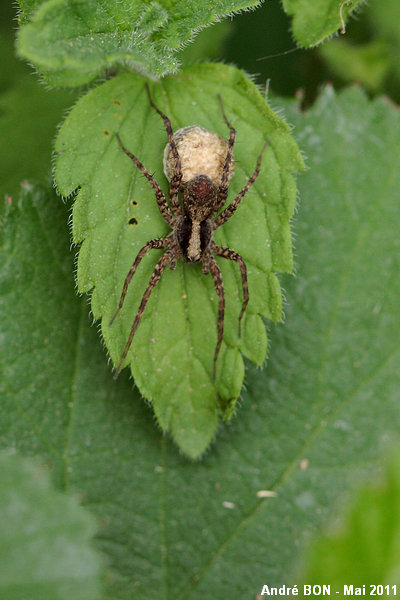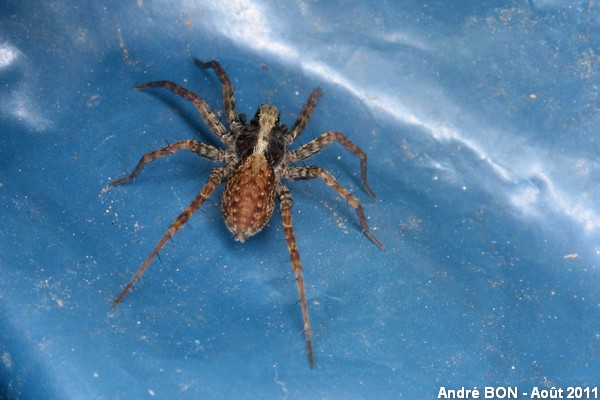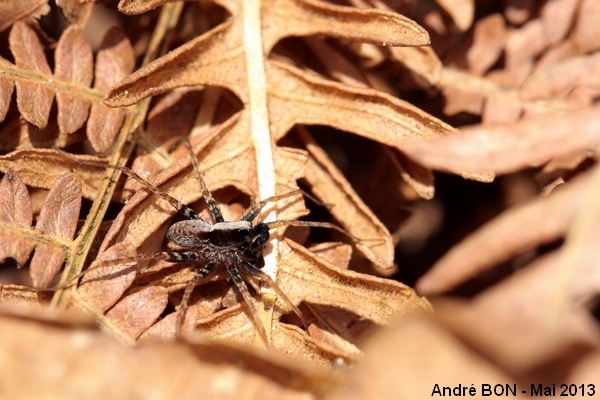



| Pardosa of the lugubris group (Pardosa (lugubris) sp. (Walckenaer, 1802)) |




|
|
Scientific name: Pardosa (lugubris) sp. (Walckenaer, 1802) Common name: Pardosa of the lugubris group Other names: Wolf Spiders of the lugubris group. This group includes Pardosa lugubris Walckenaer, 1802 , Pardosa alacris C. L. Koch, 1833 et Pardosa saltans Töpffer-Hoffmann, 2000 (and Pardosa baehrorum Kronestedt, 1999, missing in France). French name: Pardoses du groupe lugubris Order: Araneae Family: Lycosidae Size: Males: 4 to 5 mm; Females: 5 to 6 mm, up to 7 mm for Pardosa lugubris. Biotope: Deciduous forests, on the ground in the litter, woodland edges, clearings, sunny places. Web: No web. Observation period: Spring, early summer. Geographic area: Palaearctic region for Pardosa lugubris, Europe and Russia for Pardosa alacris, Europe for Pardosa saltans. To consider with some reserves as these species have been separated recently. |
Spiders of the Lycosidae family do not spin webs. They hunt by running and jumping on their preys. You can usually observe them on the ground or on low vegetation. You can recognize them with their big hind eyes looking forward. You can tell apart spiders of the Pardosa genus by the long perpendicular spines on their legs, mainly visible on the hind legs. It is very difficult to tell species apart from a picture. The marks on the upper side of the cephalothorax can give an indication. You can tell apart Pardosa of the lugubris group with the broad pale longitudinal band on the middle of the cephalothorax, with straight edges and slightly wider at the front. It runs from the front of the head and is still rather wide at the junction with the abdomen. It continues on the front of the abdomen like some kind of white dusting, mainly visible on males. The cephalothorax is dark brown on both sides, almost black on males. The abdomen is brown without any specific mark. The legs of females are ringed and spotted, pale brown, dark brown. The legs of males are dark brown from the base to the apex of the femora and then uniform pale brown. The species have been separated recently. This has been initiated by the observation of different forms of nuptial display and confirmed by the detection of morphological differences, which are not visible on pictures shot in the field. |
| [To know more about the Pardosa of the lugubris group] [Next picture] [Top] |

|
You can observe numerous Pardosa of the lugubris groups, along forest tracks, in spring. You mainly see females walking and carrying their cocoon attached under their spinnerets. |
| [To know more about the Pardosa of the lugubris group] [Next picture] [Previous picture] [Top] |

|
This female is a darker colour and you can better see the white dusting at the front of the abdomen. |
| [To know more about the Pardosa of the lugubris group] [Next picture] [Previous picture] [Top] |

|
I am not used to observing Wolf Spiders of the lugubris group in my garden. However you can explain this observation by the close distance to the forest where you can find many of them among the litter. |
| [To know more about the Pardosa of the lugubris group] [Previous picture] [Top] |

|
I have observed this spider on the litter in the forest. The pedipalps and the dark femora contrasting with the remaining light-coloured parts of the legs are typical of one male. However I am surprised by the femora which are ringed (at least on the upper side) while I was expecting a uniform dark colour. |